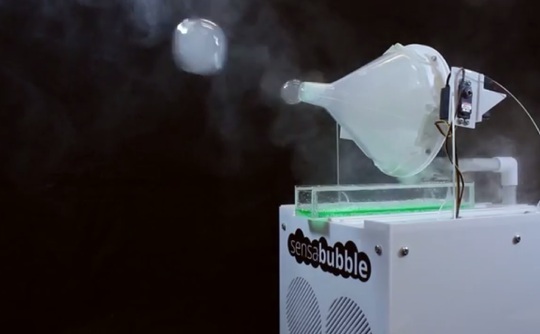Bristol University researchers have developed a novel form of human-machine interaction with SensaBubble, a multi-sensory technology that can fog bubbles with several pre-selected smells and project images on them. The team calls SensaBubble a “chrono-sensory mid-air display system” – a computer-controlled cannon that shoots soap-bubbles containing scent at a user, projecting a specific color or an image mid-air. The scent gets released as and when the bubble bursts, and given their size and color, they can display anything ranging from a logo to an email notification to an advertisement.

Professor Sriram Subramanian from the University of Bristol’s Department of Computer Science is leading the research. The technology creates a bubble of specific size and frequency, impregnates it with an opaque fog (optionally scented) and monitors their route, tracks their location, and if needed project an image on the bubble. Bubble size created may range from small, medium or large. This technology, the university believes, could be employed in segments such as education and gaming and “encourage a new way of thinking about multi-sensory technologies”.
The university stated that by incorporating chrono-sensory experiences, different layers of information are introduced through different senses for variable lengths of time, each causing different types of interest in the user. The projected visual display lasts only until the bubble is burst, post which the scent gets released which slowly disperses leaving a long-lasting noticeable vestige. Prof Subramanian stated that there are but a few research systems exploring this kind of technology, and their team had taken the first steps to see how the smell factor could be used enhance a visual object like a soap bubble.
Subramanian believes that this technology could be employed almost anywhere where interactive technologies – that are directly targeted at generating public interest and drawing users’ attention – are demanded. For example, he states, this technology could be applied to a clock, where every smell shall correspond to a different hour, or to an educational game called ‘Sensabubble Maths’, where smell shall be incorporated as feedback on children’s success.
Bristol University researchers have developed a novel form of human-machine interaction with SensaBubble, a multi-sensory technology that can fog bubbles with several pre-selected smells and project images on them. The team calls SensaBubble a “chrono-sensory mid-air display system” – a computer-controlled cannon that shoots soap-bubbles containing scent at a user, projecting a specific color or an image mid-air. The scent gets released as and when the bubble bursts, and given their size and color, they can display anything ranging from a logo to an email notification to an advertisement.
Professor Sriram Subramanian from the University of Bristol’s Department of Computer Science is leading the research. The technology creates a bubble of specific size and frequency, impregnates it with an opaque fog (optionally scented) and monitors their route, tracks their location, and if needed project an image on the bubble. Bubble size created may range from small, medium or large. This technology, the university believes, could be employed in segments such as education and gaming and “encourage a new way of thinking about multi-sensory technologies”.
The university stated that by incorporating chrono-sensory experiences, different layers of information are introduced through different senses for variable lengths of time, each causing different types of interest in the user. The projected visual display lasts only until the bubble is burst, post which the scent gets released which slowly disperses leaving a long-lasting noticeable vestige. Prof Subramanian stated that there are but a few research systems exploring this kind of technology, and their team had taken the first steps to see how the smell factor could be used enhance a visual object like a soap bubble.
Subramanian believes that this technology could be employed almost anywhere where interactive technologies – that are directly targeted at generating public interest and drawing users’ attention – are demanded. For example, he states, this technology could be applied to a clock, where every smell shall correspond to a different hour, or to an educational game called ‘Sensabubble Maths’, where smell shall be incorporated as feedback on children’s success.